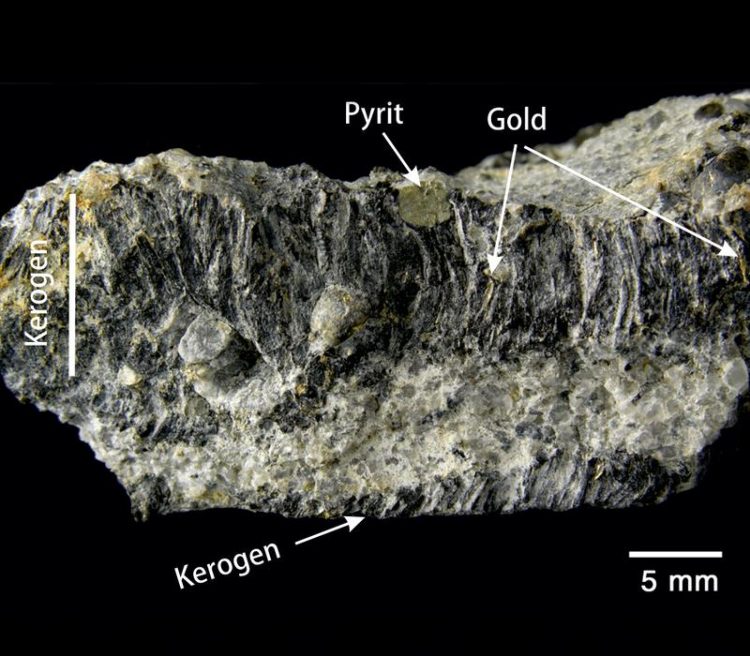No gold without microbes

Carbonaceous layer of sediment rocks, essentially consisting of kerogen, Witwatersrand basin, South Africa: an extremely rarely well preserved remnant of mats of microbes performing photosynthesis. (Photo: Hartwig Frimmel)
All the Earth’s gold deposits should actually be in the Earth’s core – buried deep out of mankind’s reach. After all, this metal has such a high density that in the course of the creation of the Earth it ought to have been moved to there. But in actual fact it also accumulated in the Earth’s crust.
Why did the gold stay there? “To this day this remains one of the most hotly debated issues in geology and geochemistry,” says Professor Hartwig Frimmel, chairman of the Department of Geodynamics and Geomaterials Research at the University of Würzburg. He is now adding a new theory to the debate, which suggests that prehistoric microbes are responsible for binding gold to the Earth’s crust.
Frimmel presents his idea in detail in the journal “Mineralium Deposita”. The Würzburg scientist is regarded as the world’s leading expert in gold deposits. He spent a long time as a professor at the University of Cape Town conducting research in South Africa’s Witwatersrand region, among others. This is where the world’s largest concentration of gold in the Earth’s crust can be found.
Where there is a lot of gold, there are also the remains of bacteria
What do microbes have to do with gold? “Wherever there are large quantities of gold, there are also layers of stratified carbonaceous substances that are of biological origin,” says Frimmel. “We have found evidence to suggest that these are the remains of cyanobacteria.” These original microbes inhabited the coastal regions of the Earth three billion years ago.
The cyanobacteria were the first living organisms that performed photosynthesis and first created “whiffs of oxygen”, as Frimmel says. The Earth at that time was still largely hostile to life: Rain had roughly the acidity of vinegar, and the surface water was rich in hydrogen sulfide.
Where there was oxygen, gold was bound
“But under precisely these conditions gold becomes extremely soluble in water,” explains the professor. The rivers and other bodies of water must have been very rich in gold back then. Where this water came upon colonies of cyanobacteria arranged into mats, the gold was chemically adhered to the surface of the microbes immediately by the oxygen.
So, three billion years ago a kind of “Gold Mega Event” occurred: “The chemical conditions at that time were perfect for binding gold and enabling the formation of deposits,” believes Frimmel. Over time and in this manner, for example, the huge gold deposits were created that can be found in such places as the Witwatersrand region of South Africa. At one time 100,000 tons of the treasured metal were stored there. More than half of it has already been mined.
“First whiffs of atmospheric oxygen triggered onset of crustal gold cycle”, Hartwig E. Frimmel, Quinton Hennigh, Mineralium Deposita (2015), DOI: 10.1007/s00126-014-0574-8
Contact
Prof. Dr. Hartwig Frimmel, Department of Geodynamics and Geomaterials Research, T +49 (0)931 31-85420, hartwig.frimmel@uni-wuerzburg.de
http://www.geodynamik.geographie.uni-wuerzburg.de/geodynamik_und_geomaterialfors… Prof. Frimmel's research
Media Contact
All latest news from the category: Earth Sciences
Earth Sciences (also referred to as Geosciences), which deals with basic issues surrounding our planet, plays a vital role in the area of energy and raw materials supply.
Earth Sciences comprises subjects such as geology, geography, geological informatics, paleontology, mineralogy, petrography, crystallography, geophysics, geodesy, glaciology, cartography, photogrammetry, meteorology and seismology, early-warning systems, earthquake research and polar research.
Newest articles

NASA: Mystery of life’s handedness deepens
The mystery of why life uses molecules with specific orientations has deepened with a NASA-funded discovery that RNA — a key molecule thought to have potentially held the instructions for…

What are the effects of historic lithium mining on water quality?
Study reveals low levels of common contaminants but high levels of other elements in waters associated with an abandoned lithium mine. Lithium ore and mining waste from a historic lithium…

Quantum-inspired design boosts efficiency of heat-to-electricity conversion
Rice engineers take unconventional route to improving thermophotovoltaic systems. Researchers at Rice University have found a new way to improve a key element of thermophotovoltaic (TPV) systems, which convert heat…



